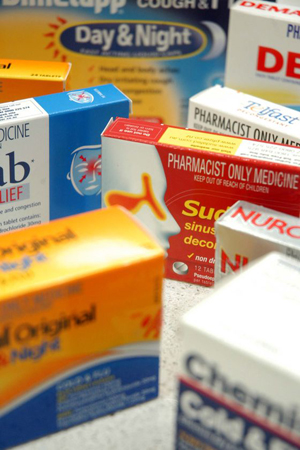Safe Cures for Kids’ Common Colds
SPH, MED research cautions against pseudoephedrine use in children

For years, at the first sign of a child’s sniffle, a parent’s instinct was to reach for the bottle of cough syrup to help relieve nasal congestion, sore throat, and fever. But when the Centers for Disease Control and Prevention linked overdoses of pseudoephedrine, a common decongestant, to the deaths of three infants in 2005, many drug manufacturers changed both their products and their marketing strategies. Pseudoephedrine was removed and replaced with phenylephrine, and pharmaceutical companies voluntarily ceased marketing all cold-and-cough medications as suitable for children under two.
The results of a new study by Boston University’s Slone Epidemiology Center show that the changes came just in time. Research conducted between 1999 and 2006 showed the drug’s common use among children in the United States, particularly among children younger than two. Now, BU researchers say, parents need to remember not to give drugs intended for adults to children in that age group, who have the highest risk for toxicity and for whom safe dosing recommendations are lacking.
 “There is some concern that because so many decongestants are no longer marketed to infants and toddlers, parents will give adult drugs to their children, which could be even more dangerous,” says lead author Louis Vernacchio, an assistant professor of epidemiology at the School of Public Health and of pediatrics at the School of Medicine.
“There is some concern that because so many decongestants are no longer marketed to infants and toddlers, parents will give adult drugs to their children, which could be even more dangerous,” says lead author Louis Vernacchio, an assistant professor of epidemiology at the School of Public Health and of pediatrics at the School of Medicine.
Although pseudoephedrine has been linked to deaths and adverse side effects, including tremors, agitation, and vomiting, among small children, the absolute risks posed to children by the decongestant are difficult to determine, Vernacchio says, because the number of children exposed to it and typical patterns of use aren’t known.
Between 1999 and 2006, Vernacchio and his team of researchers analyzed data on pseudoephedrine use among 4,267 children younger than 18 who were enrolled in the Slone Survey, a national random-digit-dial telephone survey of medication use in the U.S. population. Their findings, published in the December issue of Pediatrics, determined that 4.9 percent of children took pseudoephedrine in a given week. The drug’s use was highest in children under two (8.1 percent); 16 children (7.5 percent of users) took more than one pseudoephedrine-containing product within the same week, including 6 children under two years old. And 52 subjects (25 percent of users) took pseudoephedrine for longer than one week, including 7 children younger than two years.
Most of the pseudoephedrine products used were multiple-ingredient liquids (58.9 percent) and multiple-ingredient tablets (24.7 percent).
“Our data suggest that well over half a million children who are younger than two have been exposed to pseudoephedrine weekly in the past several years,” Vernacchio says. “This is particularly concerning given the lack of evidence for efficacy of pseudoephedrine among this age group, the absence of consumer dosing recommendations for pseudoephedrine-containing products for children who are younger than two, and the fact that infants seem to be at the highest risk for toxicity from pseudoephedrine overdose.”
The good news is that pediatric pseudoephedrine use does appear to have declined since the institution of the Combat Methamphetamine Act of 2005. In an attempt to reduce illicit methamphetamine production, this federal law requires that all pseudoephedrine-containing products be kept behind pharmacy counters and be sold to individuals in limited quantities. “This change suggests that the implementation of this act may be having the unintended benefit of reducing pseudoephedrine exposure among children and therefore potential pseudoephedrine-related toxicities,” Vernacchio says.
While parents may be tempted to give their sick children medications that contain pseudoephedrine, Vernacchio says most children’s colds don’t need to be treated with any type of drug. “The best cure for the common cold isn’t cough syrups or chewy tablets,” he says, “but warm showers and baths, humidifiers, and saline nose drops. Simple home remedy treatments are just as — if not more — effective as over-the-counter medications.”
Vicky Waltz can be reached at vwaltz@bu.edu.
Comments & Discussion
Boston University moderates comments to facilitate an informed, substantive, civil conversation. Abusive, profane, self-promotional, misleading, incoherent or off-topic comments will be rejected. Moderators are staffed during regular business hours (EST) and can only accept comments written in English. Statistics or facts must include a citation or a link to the citation.